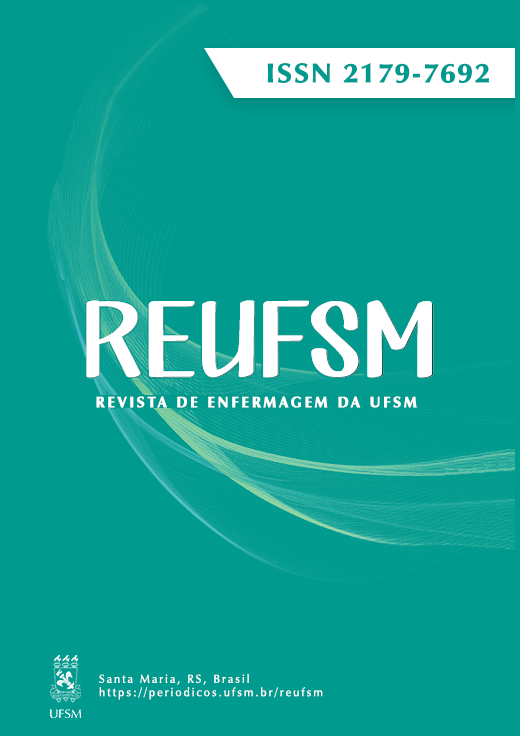Indicators of social vulnerabilities of families living in territories included in the Family Health Strategy
DOI:
https://doi.org/10.5902/2179769272165Keywords:
Social vulnerability, Human development, National health strategies, Family Health, NursingAbstract
Objective: to analyze the indicators of social vulnerabilities of families living in territories included in the Family Health Strategy (FHS) and compare the indicator per capita income with the dimensions development and autonomy, family, community and social life and income. Method: descriptive, quantitative research with 174 guardians of families living in territories with FHS. Data were collected through a questionnaire from January to March 2019. Afterwards, they were analyzed by simple descriptive statistics, mean and standard deviation. For comparison between groups, the chi-square test was used. Results: income was higher in households with a person over 60 living alone; low education and age under 16 years; families with individuals with two or more chronic diseases; and responsible for the family in informal or temporary work. Conclusion: per capita income and the family, community, and social dimension need to be considered in interventions.
Downloads
References
Martins RA, Oishi J, Manzato AJ, Ferrari F, Baida LC, Leme ET. O Sistema de Indicadores de Vulnerabilidade Familiar - SIVF do município de São José do Rio Preto, SP. Rev Bras Estud Reg Urbanos [Internet]. 2015 [acesso em 2021 ago 06];3(2). Disponível em: https://revistaaber.org.br/rberu/article/view/34
Guerra FC, Zucherato B, Gonçalves RD. Indicadores sociais a partir da cartografia de vulnerabilidade: exemplos de Bragança Paulista e Campos do Jordão (São Paulo - Brasil). InterEspaço. 2020;5(19):202015. doi: 10.18764/2446-6549.e202015
Nonato LOF, Peres AM, Khalaf DK, Souza MAR, Figueiredo KC, Lapierre J. Primary Healthcare management strategies in socially vulnerable territories exposed to violence. Rev Esc Enferm USP. 2020;54:e03608. doi: 10.1590/S1980-220X2018054903608
Gomes CS, Bernal RTI, Moreira AD, Teixeira RA, Cardoso LSM, Ribeiro ALP, et al. Estimates of hypertension and diabetes mellitus prevalence according to Health Vulnerability Index in Belo Horizonte, MG, Brazil. Rev Bras Epidemiol. 2021;24(Suppl 1):e210015. doi: 10.1590/1980-549720210015.supl.1
Calistro MO, Teixeira Y, Lacerda IRAS, Sousa SM, Agostinho Neto JA, Duavy SMP, et al. Territorialization using georreferencing and stratification of the social vulnerability of families in Primary Care. Ciênc Saúde Colet. 2021;26(6):2141-8. doi: 10.1590/1413-81232021266.39402020
Lisbôa LC, Girianelli VR, Vasconcellos LCF. Características e demandas da população em situação de vulnerabilidade social acompanhadas em Belford Roxo (RJ). Saúde Debate. 2020;438-50. doi: 10.1590/0103-1104202012512
Haggerty J, Chin MH, Katz A, Young K, Foley J, Groulx A, et al. Proactive strategies to address health equity and disparities: recommendations from a bi-national symposium. J Am Board Fam Med. 2018 May-Jun;31(3):479-83. doi: 10.3122/jabfm.2018.03.170299
Instituto Brasileiro de Geografia e Estatística (IBGE). Palmeira das Missões - Panorama [Internet]. Brasília (DF): IBGE; 2017 [acesso em 2022 out 03]. Disponível em: https://cidades.ibge.gov.br/brasil/rs/palmeira-das-missoes/panorama
Castro JA. Bem-estar social brasileiro no século XXI: da inclusão ao retorno da exclusão social. Educ Soc 2019;40:e0222141. doi: 10.1590/ES0101-73302019222141
Santos R. Jovens e adultos com baixa escolaridade, oferta de EJA e desigualdades nas chances de conclusão do ensino fundamental e do médio. Cad Estud Pesq Políticas Educ. 2019;143-74. doi: 10.24109/9788578630669.ceppe.v1a5
Cazella LG, Almeida LY, Oliveira JL, Zanetti ACG, Souza J. Qualidade de vida de mulheres e as características sociodemográficas associadas. Enferm Foco. 2019 [acesso em 2020 out 03];34-9. doi: 10.21675/2357-707X.2019.v10.n3.2448
Segawa HK, Uematsu H, Dorji N, Wangdi U, Dorjee C, Yangchen P, et al. Gender with marital status, cultural differences, and vulnerability to hypertension: findings from the national survey for noncommunicable disease risk factors and mental health using WHO STEPS in Bhutan. PLoS One. 2021;16(8):e0256811. doi: 10.1371/journal.pone.0256811
Schmidt MLG, Januário CARM, Rotoli LUM. Sofrimento psíquico e social na situação de desemprego. Cad Psicol Soc Trab [Internet]. 2018 [acesso em 2022 out 03];21(1):73-85. Disponível em: https://www.revistas.usp.br/cpst/article/view/151066
Pinho RJ, Pereira APFB, Lussi IAO. Homeless, the world of work and the specialized reference centers for population in street situation (centro pop): perspectives on actions for productive inclusion. Cad Bras Ter Ocup. 2019;27(3):480-95. doi:10.4322/2526-8910.ctoAO1842
Ribeiro KG, Andrade LOM, Aguiar JB, Moreira AEMM, Frota AC. Educação e saúde em uma região em situação de vulnerabilidade social: avanços e desafios para as políticas públicas. Interface. 2018;22(1):1387-98. doi: 10.1590/1807-57622017.0419
Noronha K, Andrade LMB, Camargos MCS, Machado CJ. Limitação funcional e cuidado dos idosos não institucionalizados no Brasil. Cad Saúde Colet. 2021;29(N Esp):59-72. doi: 10.1590/1414-462X202199010315
Xifra MJ. Perfil sociodemográfico y apoyo social percibido de personas mayores en condiciones de vulnerabilidade. Rev Ocup Hum. 2021;10-24. doi: 10.25214/25907816.996
Confortin SC, Schneider IJC, Antes DL, Cembranel F, Ono LM, Marques LP, et al. Life and health conditions among elderly: results of the EpiFloripa Idoso cohort study. Epidemiol Serv Saúde. 2017;305-17. doi: 10.5123/S1679-49742017000200008
Souza JO, Almeida MMC. Work accidents with exposure to biological material in physiotherapists according to formal and informal employment bonds. Rev Pesq Fisioter. 2020;10(4):683-91. doi: 10.17267/2238-2704rpf.v10i4.3272
Belmiro CB, Lucena CA. A relação entre juventude, trabalho e educação profissional no século XXI: uma análise sobre o Programa Jovem Aprendiz sob a perspectiva de classe social. Rev HISTEDBR On-line. 2020;20:e020046. doi: 10.20396/rho.v20i0.8653401
Villar MCO, Mourão L. Evaluation of the Young Apprentice Program through a quasi-experimental study. Trends Psychol;26(4):1999-2014. doi: 10.9788/TP2018.4-11Pt
Shin J, Lee H, Choi EK, Nam C, Chae SM, Park O. Social determinants of health and well-being of adolescents in multicultural families in South Korea: social-cultural and community influence. Front Public Health. 2021 Mar 24;9:641140. doi: 10.3389/fpubh.2021.641140.
Published
Versions
- 2023-12-01 (3)
- 2023-08-18 (2)
- 2023-08-17 (1)
How to Cite
Issue
Section
License
Copyright (c) 2023 Revista de Enfermagem da UFSM

This work is licensed under a Creative Commons Attribution-NonCommercial-ShareAlike 4.0 International License.
This work is licensed under a Creative Commons Attribution-NonCommercial-ShareAlike 4.0 International License.








